
This model is particularly effective in identifying nuanced and culturally specific toxic content, including implicit insults, sarcasm, and aggression that general-purpose systems might overlook.
- Platform Moderators: Enhance safety on social media, forums, and community platforms by detecting harmful content.
- Developers: Integrate advanced moderation into applications to ensure compliance with content policies.
- Enterprises: Protect brand integrity by filtering user-generated content across various channels.
- Researchers: Study and analyze toxic content patterns across different languages and cultures.
- Educational Institutions: Maintain respectful and safe communication within online learning environments.
🛠️ How to Use omni-moderation-latest?
- Access the OpenAI API: Ensure you have the necessary API credentials to use OpenAI's services.
- Prepare Your Input: Collect the content (text, image, or audio) you wish to moderate.
- Call the Moderation Endpoint: Send your input to the moderation endpoint, specifying omni-moderation-latest as the model.
- Review the Response: Analyze the model's output, which includes flags for various categories of unsafe content.
- Implement Appropriate Actions: Based on the flags, decide on actions such as content removal, user warnings, or further review.
Note: Detailed API documentation and examples are available on the OpenAI platform.
- Multimodal Moderation: Capable of analyzing text, images, and audio for harmful content.
- Multilingual Support: Effectively moderates content in multiple languages, including low-resource languages.
- Cultural Sensitivity: Detects culturally nuanced toxic content that other models might miss.
- Real-Time Processing: Provides swift analysis suitable for live content moderation scenarios.
- Integration Flexibility: Easily integrates into various platforms and workflows via API.
- Comprehensive Coverage: Handles multiple content types and languages effectively.
- Fast Response Times: Suitable for real-time moderation needs.
- Nuanced Understanding: Recognizes subtle forms of harmful content, including sarcasm and implicit threats.
- Easy Integration: Straightforward API allows for seamless incorporation into existing systems.
- Continuous Improvement: Regular updates enhance accuracy and expand capabilities
- Preview Status: As a preview model, it may have limitations and is not recommended for production use without thorough testing.
- Limited Transparency: Detailed information on model architecture and training data is not publicly available.
- Potential for False Positives: May flag benign content as harmful, necessitating human review.
- Contextual Limitations: Understanding of context may vary, affecting accuracy in complex scenarios.
- Access Restrictions: Usage may be subject to approval and compliance with OpenAI's use case policies.
Free
$ 0.00
Plus
$ 20.00
Pro
$ 200.00
Proud of the love you're getting? Show off your AI Toolbook reviews—then invite more fans to share the love and build your credibility.
Add an AI Toolbook badge to your site—an easy way to drive followers, showcase updates, and collect reviews. It's like a mini 24/7 billboard for your AI.
Reviews
Rating Distribution
Average score
Popular Mention
FAQs
Similar AI Tools
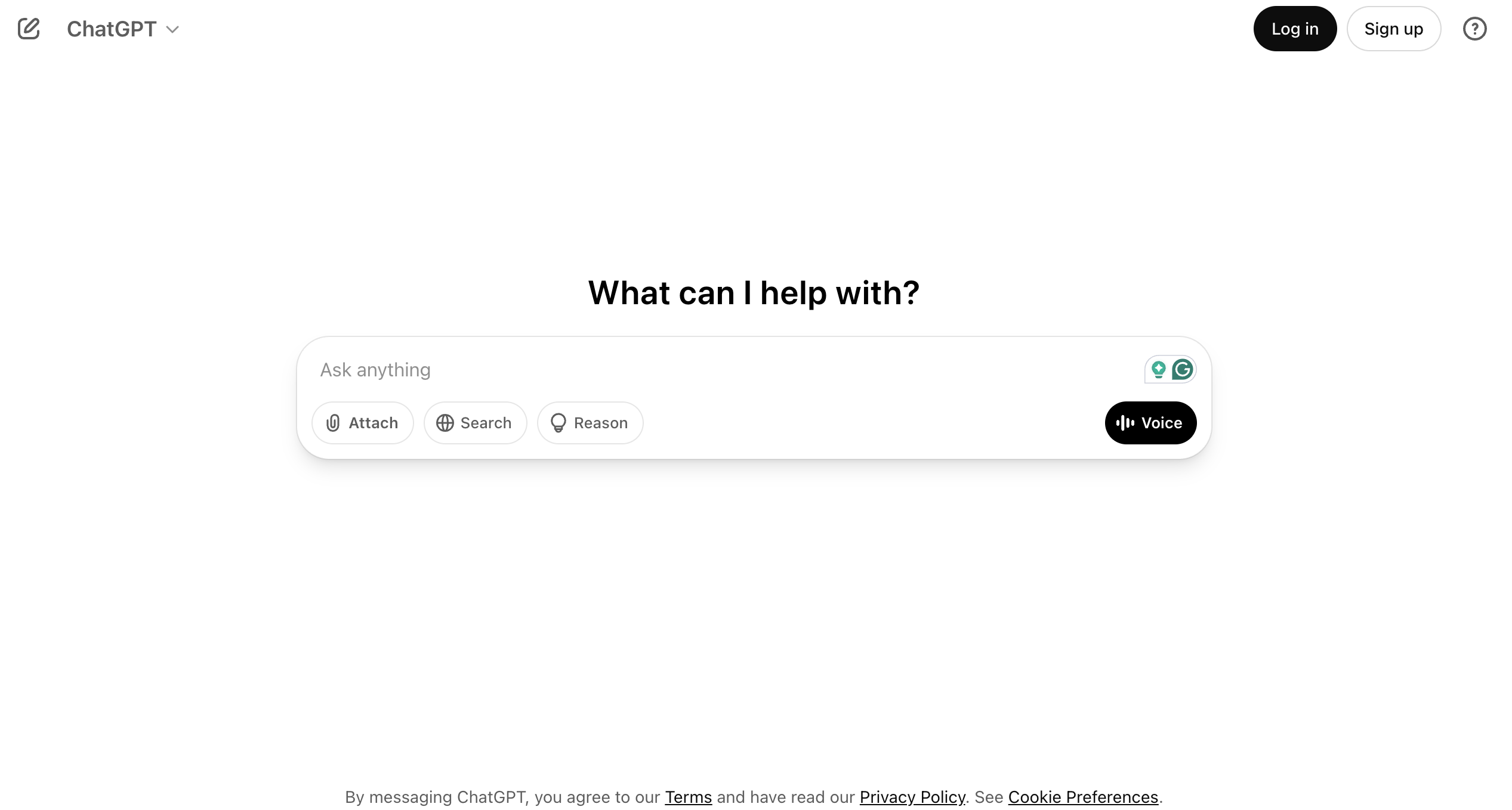

OpenAI ChatGPT
ChatGPT is an advanced AI chatbot developed by OpenAI that can generate human-like text, answer questions, assist with creative writing, and engage in natural conversations. Powered by OpenAI’s GPT models, it is widely used for customer support, content creation, tutoring, and even casual chat. ChatGPT is available as a web app, API, and mobile app, making it accessible for personal and business use.


OpenAI ChatGPT
ChatGPT is an advanced AI chatbot developed by OpenAI that can generate human-like text, answer questions, assist with creative writing, and engage in natural conversations. Powered by OpenAI’s GPT models, it is widely used for customer support, content creation, tutoring, and even casual chat. ChatGPT is available as a web app, API, and mobile app, making it accessible for personal and business use.


OpenAI ChatGPT
ChatGPT is an advanced AI chatbot developed by OpenAI that can generate human-like text, answer questions, assist with creative writing, and engage in natural conversations. Powered by OpenAI’s GPT models, it is widely used for customer support, content creation, tutoring, and even casual chat. ChatGPT is available as a web app, API, and mobile app, making it accessible for personal and business use.

text-embedding-3-large is OpenAI’s most advanced embedding model designed to convert natural language text into high-dimensional vector representations. With 3,072 dimensions per embedding and cutting-edge architecture, it offers best-in-class performance for tasks like semantic search, content recommendations, clustering, classification, and more. Built to deliver top-tier semantic understanding, this model is ideal when accuracy and relevance are mission-critical. It’s the spiritual successor to text-embedding-ada-002, bringing huge improvements in contextual understanding, generalization, and relevance scoring.


OpenAI Text Embedd..
text-embedding-3-large is OpenAI’s most advanced embedding model designed to convert natural language text into high-dimensional vector representations. With 3,072 dimensions per embedding and cutting-edge architecture, it offers best-in-class performance for tasks like semantic search, content recommendations, clustering, classification, and more. Built to deliver top-tier semantic understanding, this model is ideal when accuracy and relevance are mission-critical. It’s the spiritual successor to text-embedding-ada-002, bringing huge improvements in contextual understanding, generalization, and relevance scoring.


OpenAI Text Embedd..
text-embedding-3-large is OpenAI’s most advanced embedding model designed to convert natural language text into high-dimensional vector representations. With 3,072 dimensions per embedding and cutting-edge architecture, it offers best-in-class performance for tasks like semantic search, content recommendations, clustering, classification, and more. Built to deliver top-tier semantic understanding, this model is ideal when accuracy and relevance are mission-critical. It’s the spiritual successor to text-embedding-ada-002, bringing huge improvements in contextual understanding, generalization, and relevance scoring.


OpenAI o1-pro
o1-pro is a highly capable AI model developed by OpenAI, designed to deliver efficient, high-quality text generation across a wide range of use cases. As part of OpenAI’s GPT-4 architecture family, o1-pro is optimized for low-latency performance and high accuracy—making it suitable for both everyday tasks and enterprise-scale applications. It powers natural language interactions, content creation, summarization, and more, offering developers a solid balance between performance, cost, and output quality.


OpenAI o1-pro
o1-pro is a highly capable AI model developed by OpenAI, designed to deliver efficient, high-quality text generation across a wide range of use cases. As part of OpenAI’s GPT-4 architecture family, o1-pro is optimized for low-latency performance and high accuracy—making it suitable for both everyday tasks and enterprise-scale applications. It powers natural language interactions, content creation, summarization, and more, offering developers a solid balance between performance, cost, and output quality.


OpenAI o1-pro
o1-pro is a highly capable AI model developed by OpenAI, designed to deliver efficient, high-quality text generation across a wide range of use cases. As part of OpenAI’s GPT-4 architecture family, o1-pro is optimized for low-latency performance and high accuracy—making it suitable for both everyday tasks and enterprise-scale applications. It powers natural language interactions, content creation, summarization, and more, offering developers a solid balance between performance, cost, and output quality.


OpenAI - GPT 4.1
GPT-4.1 is OpenAI’s newest multimodal large language model, designed to deliver highly capable, efficient, and intelligent performance across a broad range of tasks. It builds on the foundation of GPT-4 and GPT-4 Turbo, offering enhanced reasoning, greater factual accuracy, and smoother integration with tools like code interpreters, retrieval systems, and image understanding. With native support for a 128K token context window, function calling, and robust tool usage, GPT-4.1 brings AI closer to behaving like a reliable, adaptive assistant—ready to work, build, and collaborate across tasks with speed and precision.


OpenAI - GPT 4.1
GPT-4.1 is OpenAI’s newest multimodal large language model, designed to deliver highly capable, efficient, and intelligent performance across a broad range of tasks. It builds on the foundation of GPT-4 and GPT-4 Turbo, offering enhanced reasoning, greater factual accuracy, and smoother integration with tools like code interpreters, retrieval systems, and image understanding. With native support for a 128K token context window, function calling, and robust tool usage, GPT-4.1 brings AI closer to behaving like a reliable, adaptive assistant—ready to work, build, and collaborate across tasks with speed and precision.


OpenAI - GPT 4.1
GPT-4.1 is OpenAI’s newest multimodal large language model, designed to deliver highly capable, efficient, and intelligent performance across a broad range of tasks. It builds on the foundation of GPT-4 and GPT-4 Turbo, offering enhanced reasoning, greater factual accuracy, and smoother integration with tools like code interpreters, retrieval systems, and image understanding. With native support for a 128K token context window, function calling, and robust tool usage, GPT-4.1 brings AI closer to behaving like a reliable, adaptive assistant—ready to work, build, and collaborate across tasks with speed and precision.


OpenAI GPT 4o Real..
GPT-4o Realtime Preview is OpenAI’s latest and most advanced multimodal AI model—designed for lightning-fast, real-time interaction across text, vision, and audio. The "o" stands for "omni," reflecting its groundbreaking ability to understand and generate across multiple input and output types. With human-like responsiveness, low latency, and top-tier intelligence, GPT-4o Realtime Preview offers a glimpse into the future of natural AI interfaces. Whether you're building voice assistants, dynamic UIs, or smart multi-input applications, GPT-4o is the new gold standard in real-time AI performance.


OpenAI GPT 4o Real..
GPT-4o Realtime Preview is OpenAI’s latest and most advanced multimodal AI model—designed for lightning-fast, real-time interaction across text, vision, and audio. The "o" stands for "omni," reflecting its groundbreaking ability to understand and generate across multiple input and output types. With human-like responsiveness, low latency, and top-tier intelligence, GPT-4o Realtime Preview offers a glimpse into the future of natural AI interfaces. Whether you're building voice assistants, dynamic UIs, or smart multi-input applications, GPT-4o is the new gold standard in real-time AI performance.


OpenAI GPT 4o Real..
GPT-4o Realtime Preview is OpenAI’s latest and most advanced multimodal AI model—designed for lightning-fast, real-time interaction across text, vision, and audio. The "o" stands for "omni," reflecting its groundbreaking ability to understand and generate across multiple input and output types. With human-like responsiveness, low latency, and top-tier intelligence, GPT-4o Realtime Preview offers a glimpse into the future of natural AI interfaces. Whether you're building voice assistants, dynamic UIs, or smart multi-input applications, GPT-4o is the new gold standard in real-time AI performance.


OpenAI Codex mini ..
codex-mini-latest is OpenAI’s lightweight, high-speed AI coding model, fine-tuned from the o4-mini architecture. Designed specifically for use with the Codex CLI, it brings ChatGPT-level reasoning directly to your terminal, enabling efficient code generation, debugging, and editing tasks. Despite its compact size, codex-mini-latest delivers impressive performance, making it ideal for developers seeking a fast, cost-effective coding assistant.


OpenAI Codex mini ..
codex-mini-latest is OpenAI’s lightweight, high-speed AI coding model, fine-tuned from the o4-mini architecture. Designed specifically for use with the Codex CLI, it brings ChatGPT-level reasoning directly to your terminal, enabling efficient code generation, debugging, and editing tasks. Despite its compact size, codex-mini-latest delivers impressive performance, making it ideal for developers seeking a fast, cost-effective coding assistant.


OpenAI Codex mini ..
codex-mini-latest is OpenAI’s lightweight, high-speed AI coding model, fine-tuned from the o4-mini architecture. Designed specifically for use with the Codex CLI, it brings ChatGPT-level reasoning directly to your terminal, enabling efficient code generation, debugging, and editing tasks. Despite its compact size, codex-mini-latest delivers impressive performance, making it ideal for developers seeking a fast, cost-effective coding assistant.
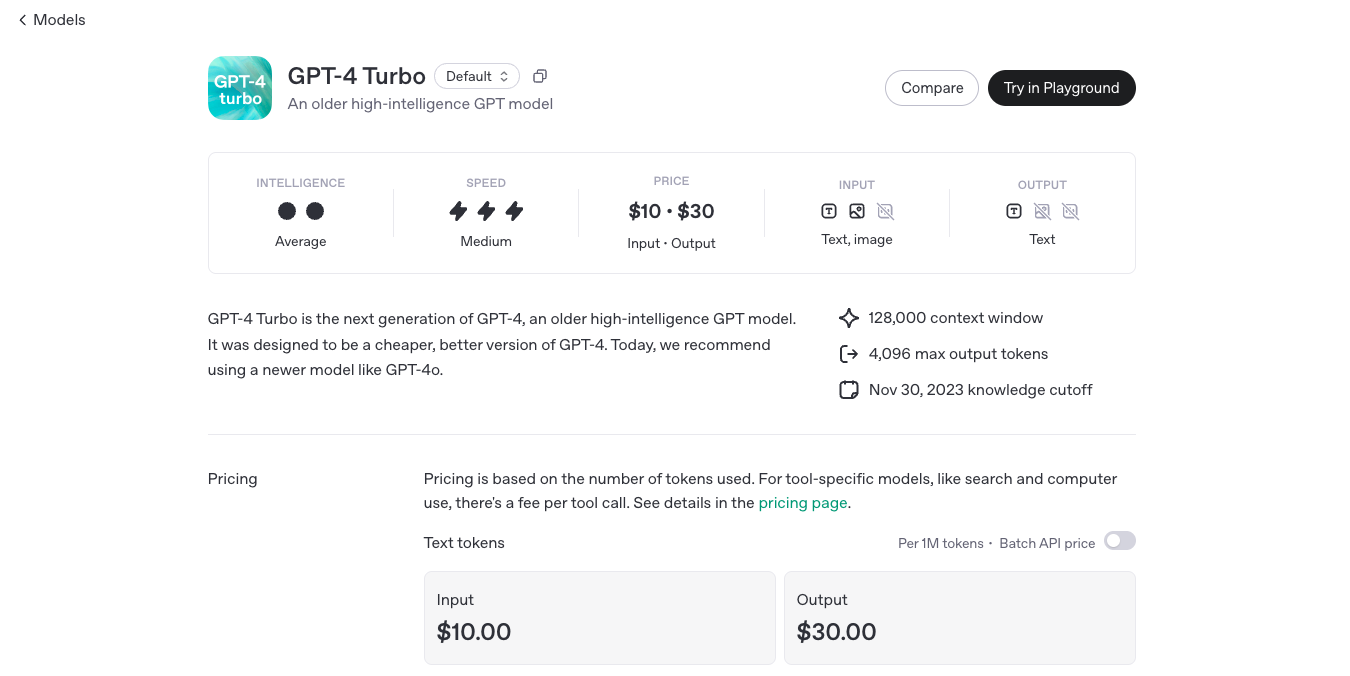

OpenAI GPT 4 Turbo
GPT-4 Turbo is OpenAI’s enhanced version of GPT-4, engineered to deliver faster performance, extended context handling, and more cost-effective usage. Released in November 2023, GPT-4 Turbo boasts a 128,000-token context window, allowing it to process and generate longer and more complex content. It supports multimodal inputs, including text and images, making it versatile for various applications.


OpenAI GPT 4 Turbo
GPT-4 Turbo is OpenAI’s enhanced version of GPT-4, engineered to deliver faster performance, extended context handling, and more cost-effective usage. Released in November 2023, GPT-4 Turbo boasts a 128,000-token context window, allowing it to process and generate longer and more complex content. It supports multimodal inputs, including text and images, making it versatile for various applications.


OpenAI GPT 4 Turbo
GPT-4 Turbo is OpenAI’s enhanced version of GPT-4, engineered to deliver faster performance, extended context handling, and more cost-effective usage. Released in November 2023, GPT-4 Turbo boasts a 128,000-token context window, allowing it to process and generate longer and more complex content. It supports multimodal inputs, including text and images, making it versatile for various applications.
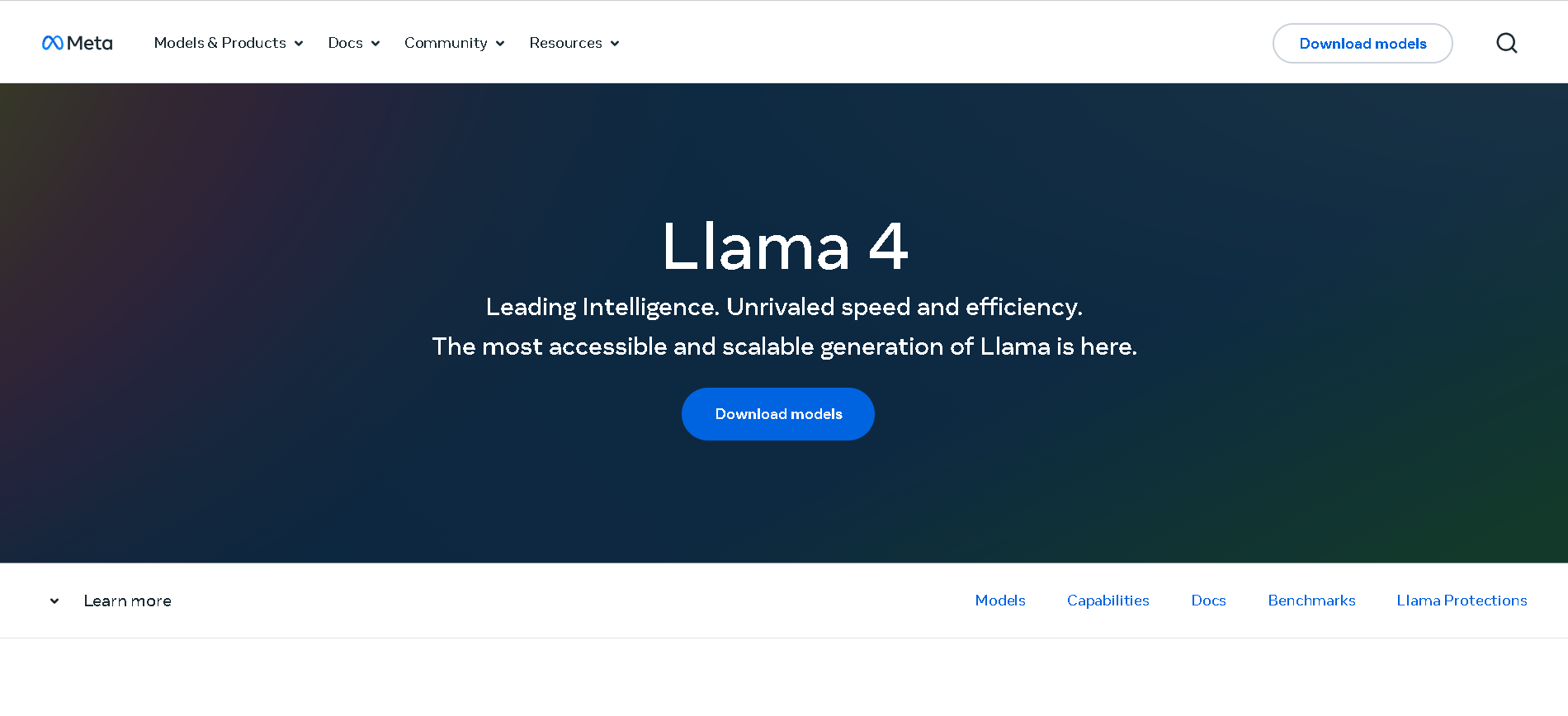

Meta Llama 4
Meta Llama 4 is the latest generation of Meta’s large language model series. It features a mixture-of-experts (MoE) architecture, making it both highly efficient and powerful. Llama 4 is natively multimodal—supporting text and image inputs—and offers three key variants: Scout (17B active parameters, 10 M token context), Maverick (17B active, 1 M token context), and Behemoth (288B active, 2 T total parameters; still in development). Designed for long-context reasoning, multilingual understanding, and open-weight availability (with license restrictions), Llama 4 excels in benchmarks and versatility.


Meta Llama 4
Meta Llama 4 is the latest generation of Meta’s large language model series. It features a mixture-of-experts (MoE) architecture, making it both highly efficient and powerful. Llama 4 is natively multimodal—supporting text and image inputs—and offers three key variants: Scout (17B active parameters, 10 M token context), Maverick (17B active, 1 M token context), and Behemoth (288B active, 2 T total parameters; still in development). Designed for long-context reasoning, multilingual understanding, and open-weight availability (with license restrictions), Llama 4 excels in benchmarks and versatility.


Meta Llama 4
Meta Llama 4 is the latest generation of Meta’s large language model series. It features a mixture-of-experts (MoE) architecture, making it both highly efficient and powerful. Llama 4 is natively multimodal—supporting text and image inputs—and offers three key variants: Scout (17B active parameters, 10 M token context), Maverick (17B active, 1 M token context), and Behemoth (288B active, 2 T total parameters; still in development). Designed for long-context reasoning, multilingual understanding, and open-weight availability (with license restrictions), Llama 4 excels in benchmarks and versatility.
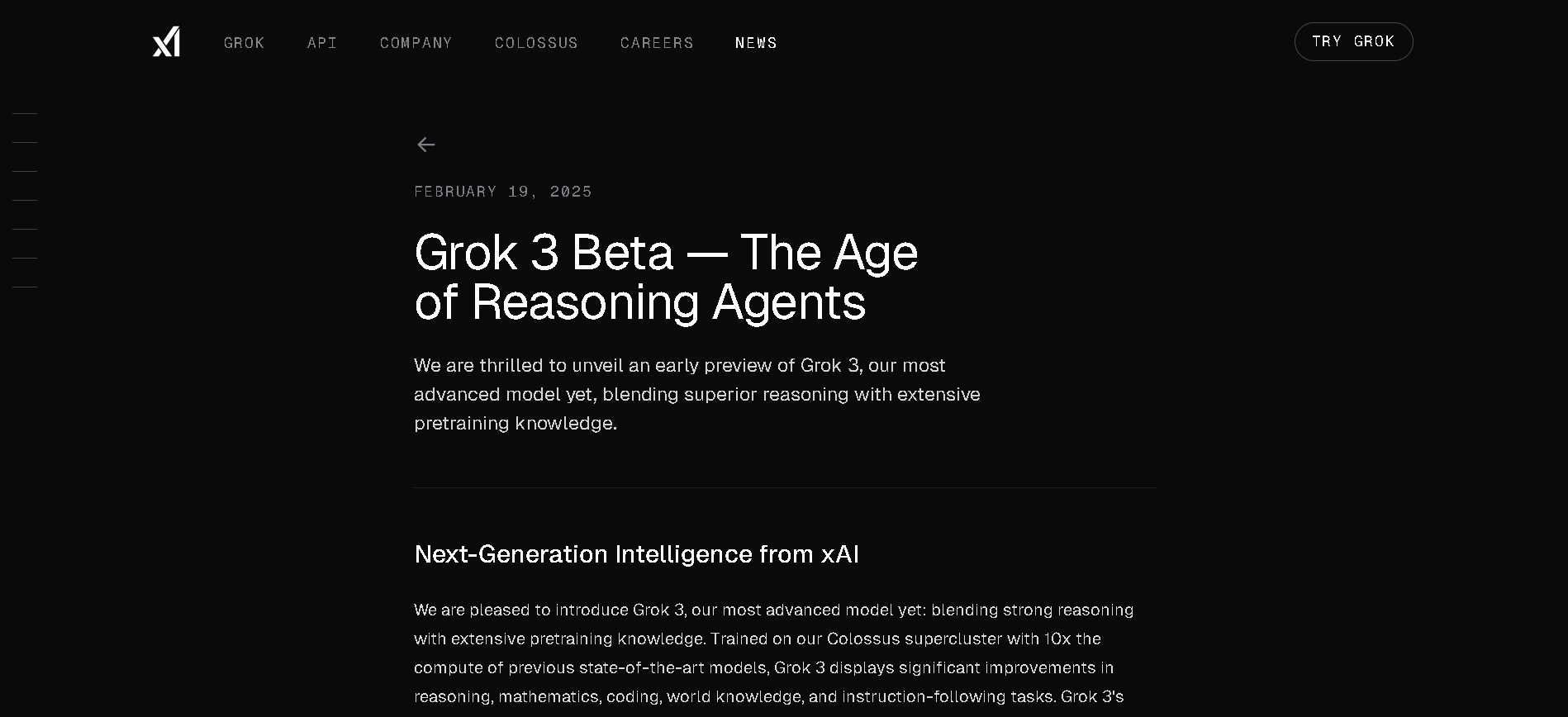
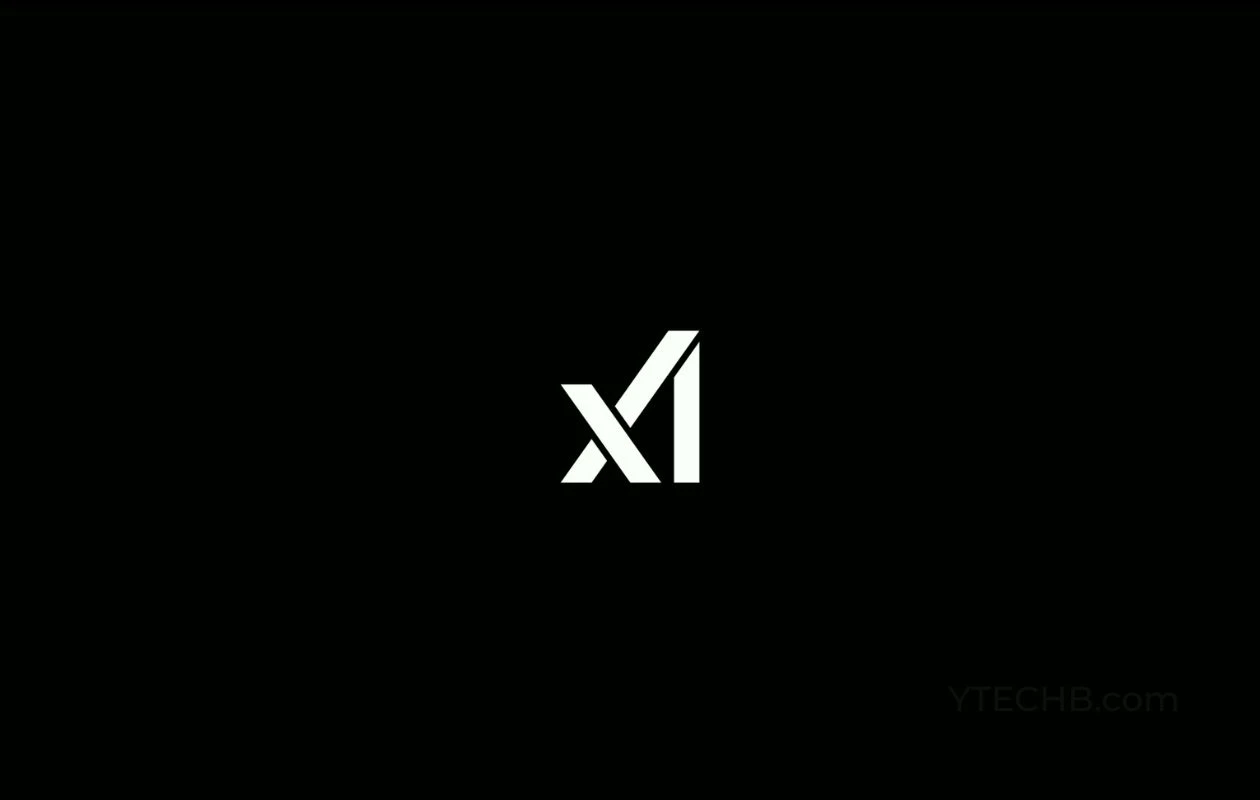
Grok 3 Latest
Grok 3 is xAI’s newest flagship AI chatbot, released on February 17, 2025, running on the massive Colossus supercluster (~200,000 GPUs). It offers elite-level reasoning, chain-of-thought transparency (“Think” mode), advanced “Big Brain” deeper reasoning, multimodal support (text, images), and integrated real-time DeepSearch—positioning it as a top-tier competitor to GPT‑4o, Gemini, Claude, and DeepSeek V3 on benchmarks.


Grok 3 Latest
Grok 3 is xAI’s newest flagship AI chatbot, released on February 17, 2025, running on the massive Colossus supercluster (~200,000 GPUs). It offers elite-level reasoning, chain-of-thought transparency (“Think” mode), advanced “Big Brain” deeper reasoning, multimodal support (text, images), and integrated real-time DeepSearch—positioning it as a top-tier competitor to GPT‑4o, Gemini, Claude, and DeepSeek V3 on benchmarks.


Grok 3 Latest
Grok 3 is xAI’s newest flagship AI chatbot, released on February 17, 2025, running on the massive Colossus supercluster (~200,000 GPUs). It offers elite-level reasoning, chain-of-thought transparency (“Think” mode), advanced “Big Brain” deeper reasoning, multimodal support (text, images), and integrated real-time DeepSearch—positioning it as a top-tier competitor to GPT‑4o, Gemini, Claude, and DeepSeek V3 on benchmarks.
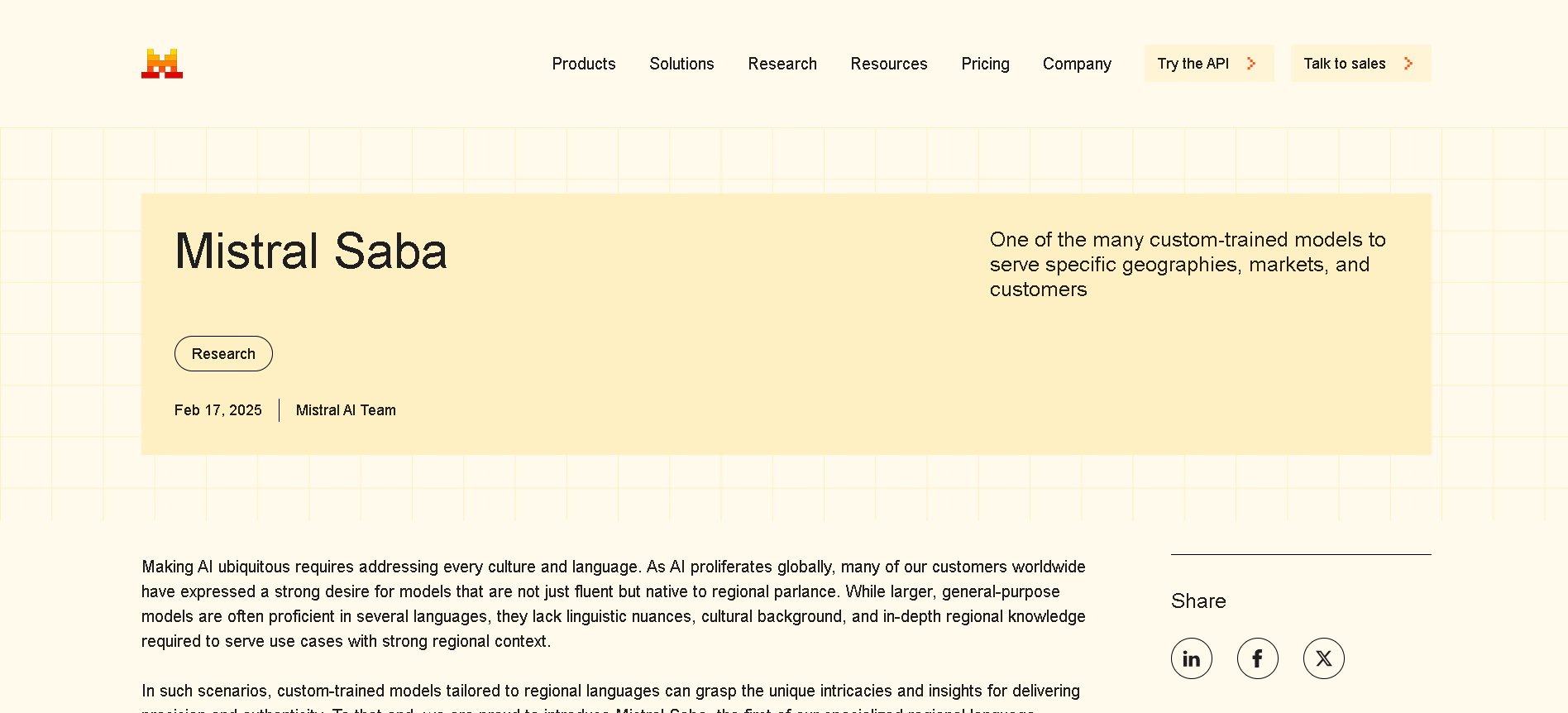
Mistral Saba
Mistral Saba is a 24 billion‑parameter regional language model launched by Mistral AI on February 17, 2025. Designed for native fluency in Arabic and South Asian languages (like Tamil, Malayalam, and Urdu), it delivers culturally-aware responses on single‑GPU systems—faster and more precise than much larger general models.

Mistral Saba
Mistral Saba is a 24 billion‑parameter regional language model launched by Mistral AI on February 17, 2025. Designed for native fluency in Arabic and South Asian languages (like Tamil, Malayalam, and Urdu), it delivers culturally-aware responses on single‑GPU systems—faster and more precise than much larger general models.

Mistral Saba
Mistral Saba is a 24 billion‑parameter regional language model launched by Mistral AI on February 17, 2025. Designed for native fluency in Arabic and South Asian languages (like Tamil, Malayalam, and Urdu), it delivers culturally-aware responses on single‑GPU systems—faster and more precise than much larger general models.
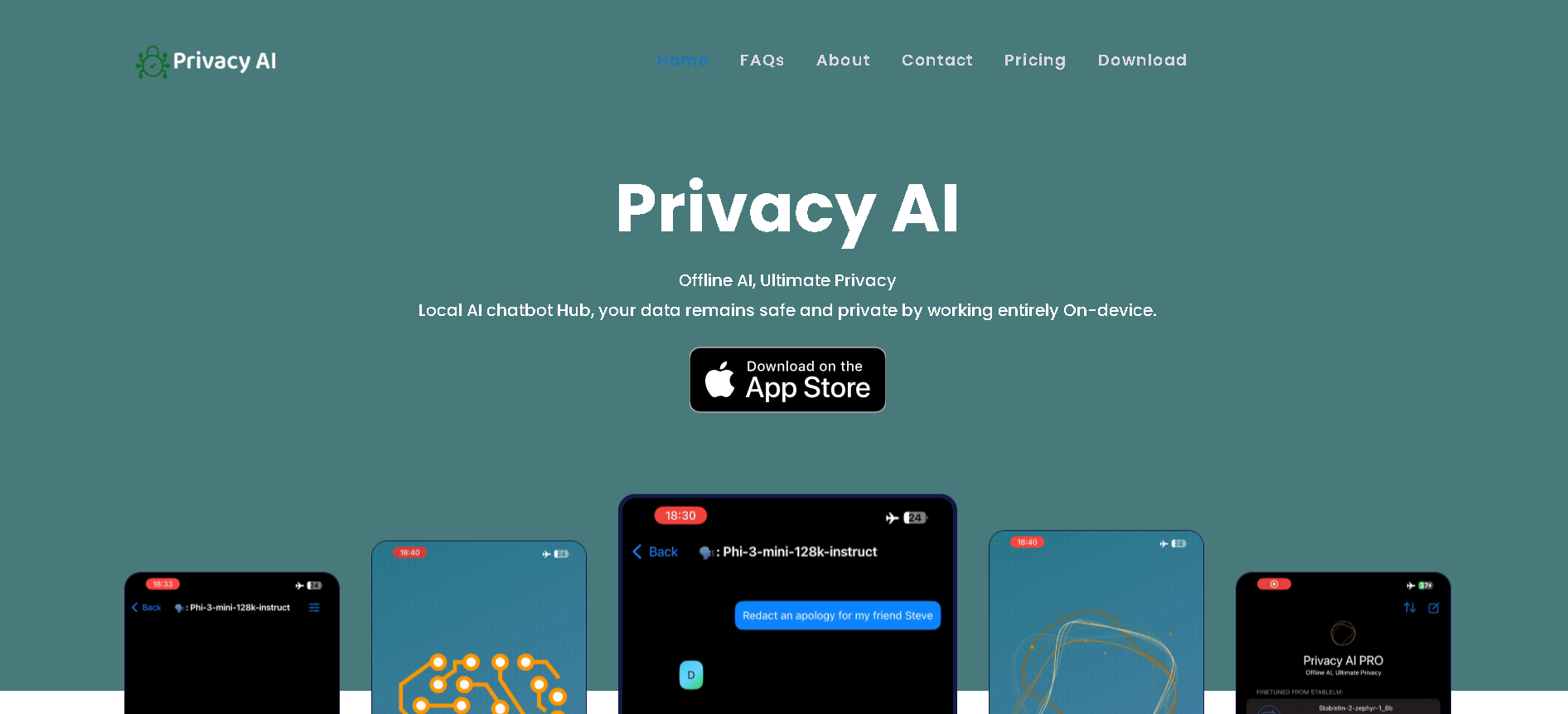
Privacy AI
Privacy AI is a mobile and desktop application designed to offer a completely offline and private AI chatbot experience. It processes all user interactions directly on the device, ensuring that no data is collected or shared, and eliminating the need for an internet connection after the initial download of AI models.

Privacy AI
Privacy AI is a mobile and desktop application designed to offer a completely offline and private AI chatbot experience. It processes all user interactions directly on the device, ensuring that no data is collected or shared, and eliminating the need for an internet connection after the initial download of AI models.

Privacy AI
Privacy AI is a mobile and desktop application designed to offer a completely offline and private AI chatbot experience. It processes all user interactions directly on the device, ensuring that no data is collected or shared, and eliminating the need for an internet connection after the initial download of AI models.
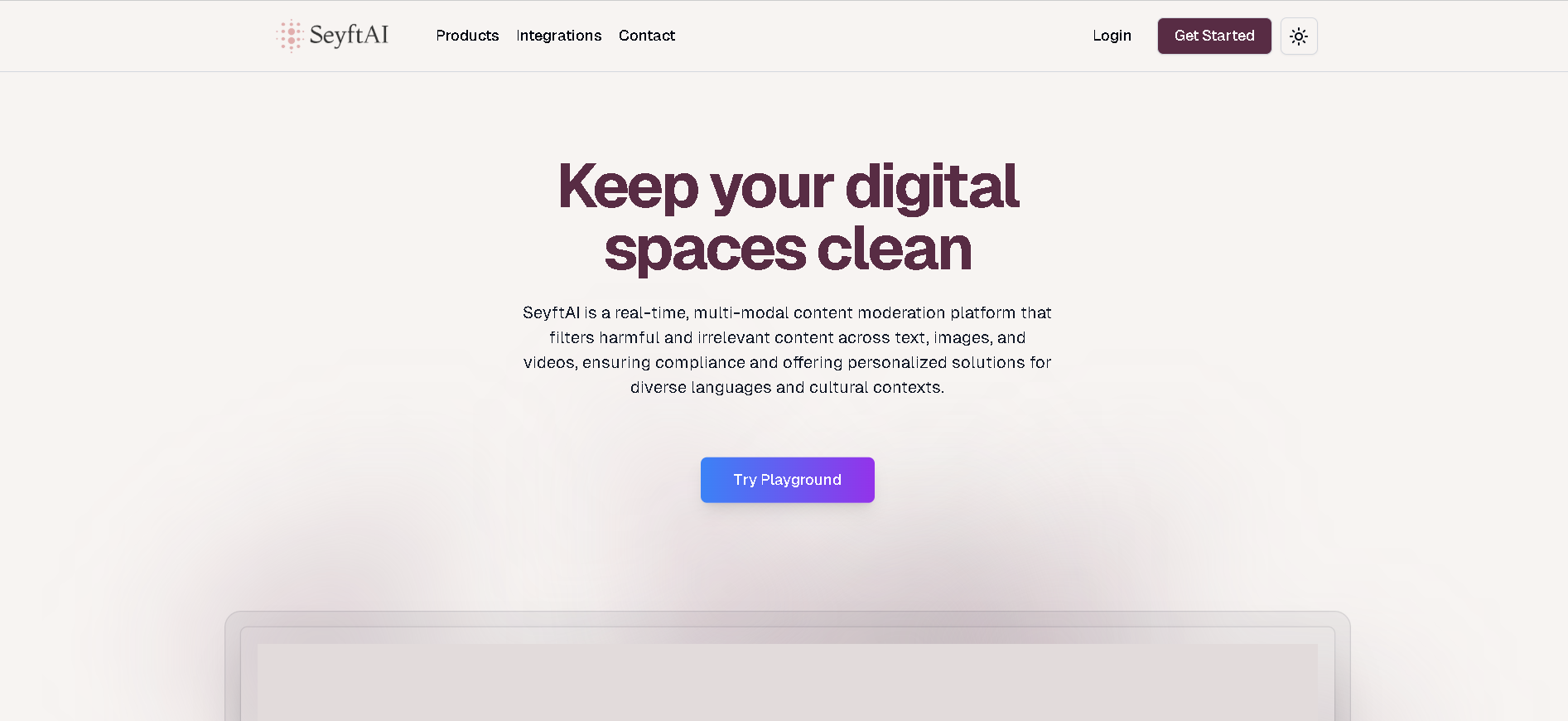
SeyftAI
SeyftAI is a real-time, multi-modal content moderation platform powered by AI, designed to ensure digital spaces remain clean and safe. It effectively filters harmful and irrelevant content across various formats, including text, images, and videos, while ensuring compliance with content policies and offering personalized solutions for diverse languages and cultural contexts.

SeyftAI
SeyftAI is a real-time, multi-modal content moderation platform powered by AI, designed to ensure digital spaces remain clean and safe. It effectively filters harmful and irrelevant content across various formats, including text, images, and videos, while ensuring compliance with content policies and offering personalized solutions for diverse languages and cultural contexts.

SeyftAI
SeyftAI is a real-time, multi-modal content moderation platform powered by AI, designed to ensure digital spaces remain clean and safe. It effectively filters harmful and irrelevant content across various formats, including text, images, and videos, while ensuring compliance with content policies and offering personalized solutions for diverse languages and cultural contexts.
Editorial Note
This page was researched and written by the ATB Editorial Team. Our team researches each AI tool by reviewing its official website, testing features, exploring real use cases, and considering user feedback. Every page is fact-checked and regularly updated to ensure the information stays accurate, neutral, and useful for our readers.
If you have any suggestions or questions, email us at hello@aitoolbook.ai
